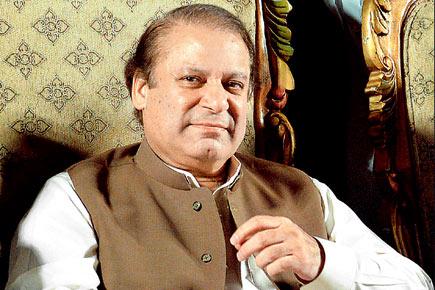In her essay, ‘Islamisation of Jinnah’ (Newsline, Pakistan, February 2014), Ayesha Siddiqa described Pakistan as ‘a hybrid-theocracy in which there are limited visible spaces where Islamic Sharia is formally implemented along with a depleted number of liberals and liberal space, but with a larger space in which religious laws and norms are implemented informally.”


In her essay, ‘Islamisation of Jinnah’ (Newsline, Pakistan, February 2014), Ayesha Siddiqa described Pakistan as ‘a hybrid-theocracy in which there are limited visible spaces where Islamic Sharia is formally implemented along with a depleted number of liberals and liberal space, but with a larger space in which religious laws and norms are implemented informally.”
ADVERTISEMENT

The creed of violence has taken over and fear is the key. No wonder Pak Prime Minister Nawaz Sharif is hesitant about launching military operations into FATA
In Pakistani society, “the religious right has strengthened considerably, where reason and rationality is not worth claiming even by the educated lest someone doubts their faith, those that do not subscribe to the majority faith are shunned and looked down upon, and where the propensity for violence has increased manifold.” Siddiqa is one of Pakistan’s foremost analysts and her views need to be taken seriously. There are others, too, but perhaps, increasingly, they belong to a shrinking and maybe frightened group.
In my chapter ‘The Talibanisation of Pakistan and The Growth of Jihadi Culture’ (National Security Review 2009) I had quoted from Pervez Hoodbhoy’s article ‘The Saudi-isation of Pakistan’ where he said, “Pakistan’s self-inflicted suffering comes from an education system that, like Saudi Arabia’s, provides an ideological foundation for violence and future jihadists.” Today, Western scholars like Stephen Tankel speak of the Pakistanisation of Al-Qaeda and Michael Kugelman has written wondering, “Could Pakistan become a Sharia state?”
Two distinct hubs operate in Pakistan — the Afghanistan hub which comprises Mullah Omar’s Islamic Emirate of Afghanistan (the Quetta Shura of Taliban), Haqqani Network, Tehrik Taliban Pakistan, Gulbuddin Hikmetyar’s Hizb-e-Islami and Al-Qaeda. They operate in and from Afghanistan, Khyber PakhtunKhwa, FATA and Balochistan extending up to Karachi, which is the largest Pakhtun city in the world.
The other hub is in Punjab, which has essentially been India-specific and consists of Lashkar-e-Tayyiba (or Jamat-ut Dawa) — (LeT), Jaish-e-Mohammed-(JeM), Harkat-ul-Mujahedeen, the Sunni sectarian Sipaha-e-Sahaba (SSP) also known as Lashkar-e-Jhangvi and Ahle Wal Sunnat Jamaat. The sectarian militant groups are used as rapid deployment forces for periodically eliminating Shias and other minorities.
There is an ideological unity among all these Afghan and Punjab groups and this includes the Al-Qaeda. There has been considerable speculation that Al-Qaeda may have been behind the attacks on Pakistan’s nuclear facilities in 2007 and 2008, had helped the massive jail breaks in Bannu and Dera Ismail Khan and had cooperated with Haqqani Networks in the attack on the CIA camp in Khost.
Meanwhile, JuD leaders promise a nuclear umbrella to all Muslim countries. There have been reports of TTP militants volunteering for jihad in Syria. And, significantly, Al-Qaeda’s media section increasingly produces video tapes that are in Urdu. Pakistan is clearly Al-Qaeda’s emerging base helped along by its other affiliates like the LeT and JeM.
Recently, persons unhappily familiar to Indians, like Mast Gul of Charar-e-Sharif infamy, Masood Azhar of Jaish-e-Mohammed and the Kashmiri terrorist Mushtaq Zargar have resurfaced. Obviously, something is afoot. Terrorist groups — the LeT, JeM, and SSP/LeJ now have a permanent presence in Pakistani society and could acquire influence in the way Hamas and Hizbollah have done in Gaza and Lebanon, as was pointed out by Tufail Ahmed in his article ‘The Next Decade of Jihadism in Pakistan’ (June 2013).
The creed of violence has taken over and fear is the key. No wonder Prime Minister Nawaz Sharif is hesitant about launching military operations into FATA. Interestingly, the TTP has continued to bomb and kill in Peshawar and Karachi, behead 23 Pakistani soldiers as revenge and offer a ceasefire.
Meanwhile, Pakistan media has been giving prime time coverage to TTP negotiators (also described as stakeholders), either out of conviction or fear. Naturally, this coverage has helped the TTP reach Pakistani homes and talk about their 15 demands which will be difficult for the government to accept or refuse. The debate is not so much about Sharia law but how much Sharia law is good.
Once again, commenting on what the future could look like, Ayesha Siddiqa said that if the talks succeeded Pakistan may actually metamorphose from a hybrid theocracy to a complete theocracy because the Taliban, good or bad, want implementation of the Sharia. Thus all would depend on how far Pakistan’s military and civilian leadership want to go to accommodate Taliban demands or prefer to wage war against TTP and those who have been Pakistan Army’s strategic assets in Afghanistan and India.
An operation into FATA in March has been planned but the Taliban have enough time to hide and live to fight another day. Or is it too late and are we looking at an Islamic Emirate of Pakistan?
The writer is a former chief of Research and Analysis Wing (RAW)
 Subscribe today by clicking the link and stay updated with the latest news!" Click here!
Subscribe today by clicking the link and stay updated with the latest news!" Click here!







